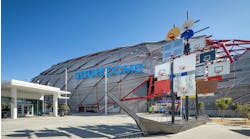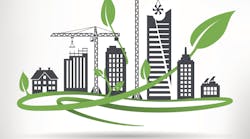Latest from Green
Sponsored
U.S. Green Building Council releases its annual Top 10 States for LEED Green Building
WASHINGTON, D.C. — Today, the U.S. Green Building Council (USGBC) announced its annual Top 10 States for LEED, the world’s most widely used and recognized green building rating system. The per-capita list highlights states throughout the country that are making significant strides in sustainable building design, construction and transformation. LEED-certified spaces use less energy and water resources, save money for families, businesses and taxpayers, reduce carbon emissions, create jobs and establish a healthier environment for residents, workers and the larger community.
“Green construction is quickly outpacing conventional construction in the U.S.,” said Rick Fedrizzi, CEO and founding chair of USGBC. “LEED has become an essential tool for the transformation of building design and construction. By recognizing these states excelling in the use of LEED, we are celebrating the green building professionals, architects, business, policy and community leaders who work tirelessly to design and develop innovative solutions toward a healthier, more sustainable future. LEED construction drives economic growth, creates jobs and makes communities greener.”
*Included in 2014 Top 10 States for LEED list **Washington, D.C. is not ranked as it is a federal district, not a state Notable projects certified in 2015’s Top 10 States for LEED include: Illinois: Virgin Hotel Chicago; LEED Gold Maryland: Holy Cross Hospital in Germantown; LEED Gold Massachusetts: New Douglas Elementary School in Douglas; LEED Silver Washington: University of Washington Husky Stadium, the largest stadium, college or professional, in the Pacific Northwest, in Seattle; LEED Silver Colorado: North Colorado Springs Readiness Center home to the Colorado National Guard;LEED Platinum Nevada: Clark County Wetlands Park Nature Center in Las Vegas; LEED Gold California: Los Angeles Convention Center Recertification; LEED Gold Texas: The Treehouse at Memorial City, part eco office and part club house in Houston; LEED Platinum Virginia: Chesapeake Bay Foundation Virginia Environmental Center in Virginia Beach; LEED Platinum Utah: U.S. District Courthouse in Salt Lake City; LEED Gold Collectively, 1,633 commercial and institutional projects became LEED certified within the Top 10 States for LEED in 2015, representing 274.9 million square feet of real estate. Worldwide, 4,837 projects were certified in 2015, representing 818.9 million square feet. USGBC calculates the list using per-capita figures as a measure of the human element of green building. This also allows for fair comparisons among states with significant differences in population and number of buildings. In 2015, LEED for Building Operations and Maintenance was once again the most popular rating system within the top 10 states, representing 49 percent of the total square footage certified. LEED for Building Design and Construction was the second most popular rating system in the top 10, representing 46 percent of the square footage certified and LEED for Interior Design and Construction was the third most popular rating system, representing 5 percent of total square footage certified in these states in 2015. The LEED green building certification system is the foremost program for the design, construction, maintenance and operations of green buildings. More than 52,000 commercial, neighborhood and residential projects are currently LEED certified, comprising more than 5 billion square feet of construction space in all 50 states in the U.S. and in more than 150 countries and territories globally. Green construction is a large economic driver. According to the 2015 USGBC Green Building Economic Impact Study, green construction will account for more than 3.3 million U.S. jobs–more than one-third of the entire U.S. construction sector–and generate $190.3 billion in labor earnings. The industry’s direct contribution to U.S. Gross Domestic Product (GDP) is also expected to reach $303.5 billion from 2015-2018.



